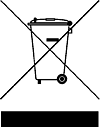Proposition 65, officially the Safe Drinking Water and Toxic Enforcement Act of 1986, is a law that requires warnings be provided to California consumers when they might be exposed to chemicals identified by California as causing cancer or reproductive toxicity. The warnings are intended to help California consumers make informed decisions about their exposures to these chemicals from the products they use. The California Office of Environmental Health Hazard Assessment (OEHHA) administers the Proposition 65 program and publishes the listed chemicals, which includes more than 850 chemicals. In August 2016, OEHHA adopted new regulations, effective on August 30, 2018, which change the information required in Proposition 65 warnings.
We are providing the following warning for products linked to this page:
 WARNING:
WARNING: This product can expose you to chemicals, which is [are] known to the State of California to cause cancer and birth defects or other reproductive harm. For more information go to
www.P65Warnings.ca.gov.
It is important to note that these warnings do not mean the specified products will necessarily cause cancer or reproductive harm. A proposition 65 warning does not mean that a product is in violation of any safety standards or requirements. When products are used as designed for their intended purpose, we believe the products are not harmful.
WEEE
 The European Union adopted Directive 2002/96/EC on Waste Electrical and Electronic Equipment (WEEE) with their publication in the Official Journal of the European Union on February 13th, 2003. WEEE is for the prevention, reuse, recycling and recovery to reduce the disposal of waste from electrical and electronic equipment. Requirements for WEEE went into effect on August 13th, 2005. Current Requirements for the Revised WEEE Directive 2012/19/EU went into effect on July 4th, 2012 and Digi is compliant with this directive. Digi's products are generally easy to separate through simple mechanical separation of the enclosure from the assembly for recycling as standard electronic waste.
The European Union adopted Directive 2002/96/EC on Waste Electrical and Electronic Equipment (WEEE) with their publication in the Official Journal of the European Union on February 13th, 2003. WEEE is for the prevention, reuse, recycling and recovery to reduce the disposal of waste from electrical and electronic equipment. Requirements for WEEE went into effect on August 13th, 2005. Current Requirements for the Revised WEEE Directive 2012/19/EU went into effect on July 4th, 2012 and Digi is compliant with this directive. Digi's products are generally easy to separate through simple mechanical separation of the enclosure from the assembly for recycling as standard electronic waste.